New York's highest court of appeals has held that no-fault insurers cannot deny no-fault benefits where they unilaterally determine that a provider has committed misconduct based upon alleged fraudulent conduct. The Court held that this authority belongs solely to state regulators, specifically New York's Board of Regents, which oversees professional licensing and discipline. This follows a similar recent ruling in Florida reported in this publication.
Nat'l Centre for Multidisciplinary Studies of Back Pain
The National Centre for Multidisciplinary Studies of Back Pain is housed in the Townsville General Hospital in North Queensland, Australia.
Lynton G.F. Giles, MSc, DC(C), PhD (W Aust): chief executive officer and research director of the National Centre for Multidisciplinary Studies of Back Pain.
TOWNSVILLE, Australia -- The National Centre for Multidisciplinary Studies of Back Pain in Townsville, North Queensland, Australia is the result of years of negotiations between the vice-chancellor of James Cook University of North Queensland, the Townsville General Hospital, and the Northern Regional Health Authority. It opened on 3 July 1995 with a clinical diagnosis and treatment staff of one general medical practitioner, one medical acupuncturist, two chiropractors, and one nurse/receptionist.
Essentially the centre is a diagnostic and patient management centre for patients suffering from acute and chronic spinal pain syndromes. In the course of collecting clinical information from patients, data are collected to determine which form of therapy -- acupuncture [medical], manipulation, or medical treatment -- is most beneficial. This investigation is of great significance to the Australian community, as it is estimated that spinal pain syndromes cost the community approximately A$10 billion per annum.
The university's foresight in perceiving the necessity for such a centre in Townsville has been rewarded by an extremely positive response from patients and medical practitioners. More than 70 medical practitioners refer patients to the centre. The chief executive officer and research director, the centre now has an expanded staff to handle the dramatic increase in patients: two general medical practitioners; two medical acupuncturists (who have two locum medical acupuncturists); one chiropractor (with a locum chiropractor); and two nurse/receptionists. The centre is open on Monday, Wednesday, and Friday afternoons in Townsville General Hospital. The university provided seeding funds to establish the centre and funds are now being sought from other sources to pay the salaries of staff who are not covered by Medicare rebates (i.e., chiropractors and nurse/receptionists).
Although it is too early to analyse data regarding the three treatment modalities, it is of interest to note the number of new patients since July 1995 (Table 1) and the number of patient treatment visits during the 11 month period between December 1995 and October 1996 (Table 2).
It has become necessary to restrict the number of new patients and patient treatment visits to maintain the smooth running of the centre's operations within space and time constraints.
The centre has responded to patient requests that a patient support group be established to help chronic spinal pain sufferers to cope with their often significant disabilities.
It is too early to determine, which, if any of the three treatment modalities will be most successful. However, it is abundantly clear that the multidisciplinary team approach is benefitting the centre's patients, many of whom say, "It is wonderful to find a group of different types of doctors working together who are interested in me." This highlights the significance of the centre where patients are seen by a multidisciplinary team, members of which have expertise in different areas of health care. The clinical team is unique in that the prime objective of each member is the well-being of the patient; politics simply are not even considered.
Patients from the Townsville community are able to benefit from the multidisciplinary team approach because of two gentlemen who had the courage and conviction to support me in establishing the centre. Without the understanding and determination of Professor Ray Golding, who was vice-chancellor of James Cook University when the centre was established, and the director of medical services at Townsville General Hospital, both of whom took considerable professional risks in enabling the centre to be established, the community would not have the centre to turn to for investigation and management of complex pain syndromes. The hospital has all the modern facilities (different imaging modalities, laboratory procedures, etc.) to enable patients to be investigated completely. The head of the Department of Radiology agreed to the establishment of an erect posture radiographic facility in one of the hospital's x-ray areas and the technical staff involved with plain film radiography, CT, MRI, etc., have been particularly willing to do everything possible to accommodate the needs of our patients.
Because of the number of new patients, the centre also uses a private radiological clinic where the radiologists go out of their way to provide the centre's clinical staff with specialised technology such as CT reconstructions of regions of the spine.
Another advantage of having a multidisciplinary team in a hospital setting is that patients can easily be referred by the centre's medical practitioners to specialists within the hospital. In turn, some hospital specialists refer patients to the centre.
The centre has built a reputation for providing detailed medico-legal opinions and this has helped to underpin its role in the local community. The chief executive officer is frequently consulted in this regard. This has broken down some of the barriers where chiropractors were previously not called to give evidence in court in Queensland.
Unfortunately, the current and previous federal governments have stated that they can be of no assistance in the matter of funding for chiropractors employed at the centre. Therefore, funding for chiropractic services is an ongoing major challenge which has to be confronted.
Lynton G.F. Giles, MSc, DC(C), PhD (W Aust)
Chief Executive Officer and Research Director
National Centre for Multidisciplinary Studies of Back Pain





